Canoeing and Kayaking--A Sport for All Seasons, From White-water Rapids To Crystalline Lakes
Perhaps the British say it best: "There's nothing quite so much fun as messing about in boats." Boating seems to answer an inner human longing, and when necessity does not make us venture out on water, we do it anyway--just for pleasure. Children instinctively improvise rude rafts and embark on make-believe voyages; as adults, we daydream of romantic excursions.
Different boats are suited for different kinds of boating. A Polynesian outrigger canoe can master mountainous surf; the American Indian's bark canoe is most at home on inland waterways. The ingenuity of modern boat builders has created designs that are even more specialized: surf kayaks that can handle waves beyond the ability of an outrigger or decked white-water canoes that will wend their way through rapids that would make a salmon hesitate. With so many styles available, the cardinal consideration for successful and enjoyable boating, particularly for newcomers to the sport, is to choose the right craft for the boating you want to do. For example, a large guide-type canoe can take a family and its gear on an extended camping trip or a pair of experienced paddlers down a fairly rapid river. But it would be foolhardy to use it against a roaring western river.
If you want to try different boating experiences, you can turn to rentals. Drive a short distance and rent an inflatable raft for a bouncing gorge trip one weekend. Drive the opposite direction the next weekend and try your hand at canoeing on a placid lake. Soon you will get a feel for what kinds of boats and boating are most to your liking. With the right craft and waterway, the trip of your dreams can become a reality.
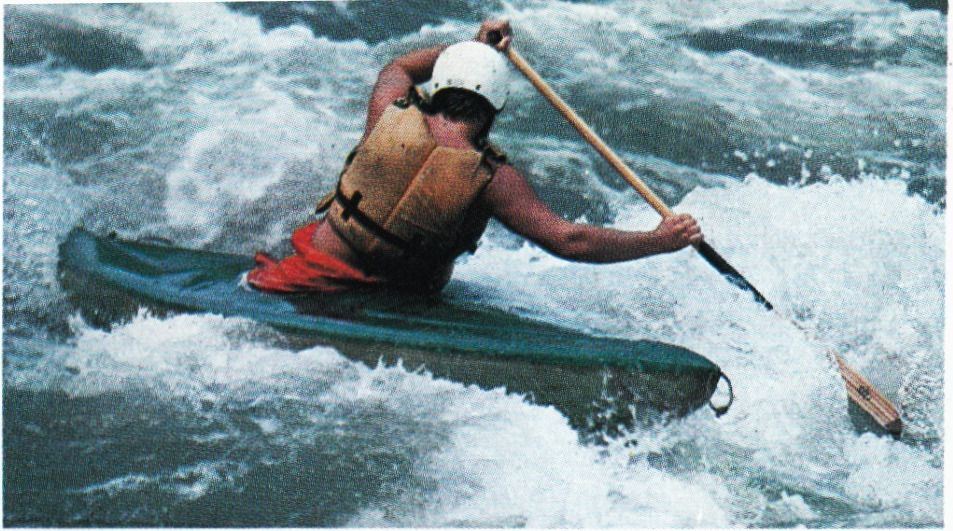
-----------White-water thrills await seasoned boaters on rivers across the
continent. Although the roughest waters are the province of experts, anyone
from a raw novice to a top pro can find a waterway that will match his skill,
experience, and type of craft.
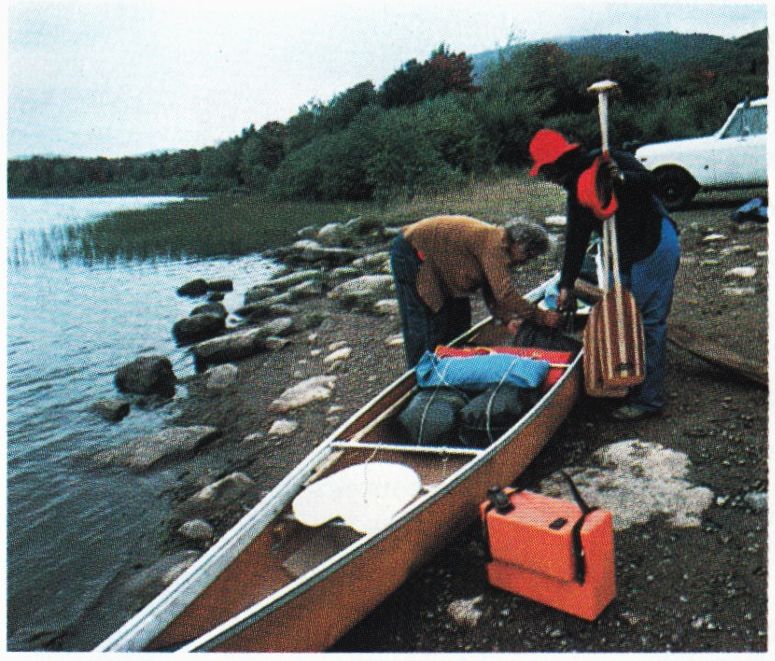
-------------Canoe camping lets boaters explore vast, virtually untouched
natural regions all across the continent. The key to such extended trips is
logistics: you must take everything with you that will be needed but still
not overload the canoe. You must also carefully plan the itinerary. If you
have to make a portage, your gear should be light. Nevertheless, occasions
may arise when you will have to fall back on the old army axiom: "When
in the field, improvise."
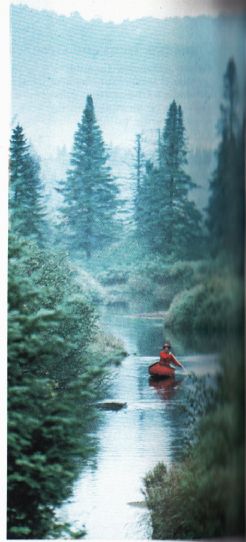
------------Getting away from it all is one the great joys of boating.
Few other sports afford the participant so calm and intimate a look at nature.
North America is especially rich in boating opportunities, containing more
fresh water in lakes and rivers rest of the world put together.
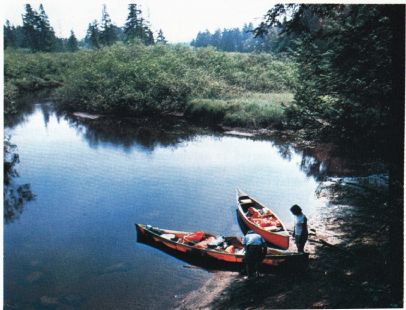
--------------When day is done, canoe campers (left) are ready for a warm
campfire, a meal of nourishing trail food, and a good rest in tents and sleeping
bags. Start scouting for a campsite several hours before dusk; otherwise night
may fall before you have had time to beach the boat, unload gear, gather firewood,
and set up camp.
Planning Your Boat Trip
Choose a watercourse that matches your boat and your skills. Otherwise you might get in over your head--literally. A stretch of river that would delight a white-water enthusiast would not be a good choice for boaters on their first canoe outing. Many boating books and magazines describe suggested trips tailored for boaters with various types of boats and various degrees of experience. Local boating clubs and outfitters can usually furnish maps and suggest watercourses in their particular area that would fit your interests and proficiency. In addition, the same clubs and outfitters often sponsor group trips and provide equipment and transportation to and from the site. Trips like these, led and organized by experienced boatsmen, are probably the safest and least ex pensive way to get started in boating.
Never plan to go boating alone, and never go without first telling a friend or relative what your planned route is and when you expect to return. Then, should you get in trouble, searchers will know when and where to start looking. Timing is also important. A body of water may be placid in summer, dried up in the fall, and a raging torrent in spring. Boating conditions may change drastically with a change of only a few feet in water level. Snags and bars you skimmed over without noticing in April may be hazardous or impassable a few months later. A lake that is smooth paddling in the morning may be windswept and choppy by mid-afternoon. When inquiring of local boaters about a trip you are planning, always mention when you intend to go. Another general safety rule: if the water temperature is much below 60° E either plan to wear an insulated wet suit or else postpone your trip to a warmer time of year. Should you get dumped, cold water will quickly sap your strength and deaden your reflexes. Many boating and swimming fatalities occur in spring when the air may be an inviting 75° F but the water is still numbing cold.
Selecting Supplies and Equipment
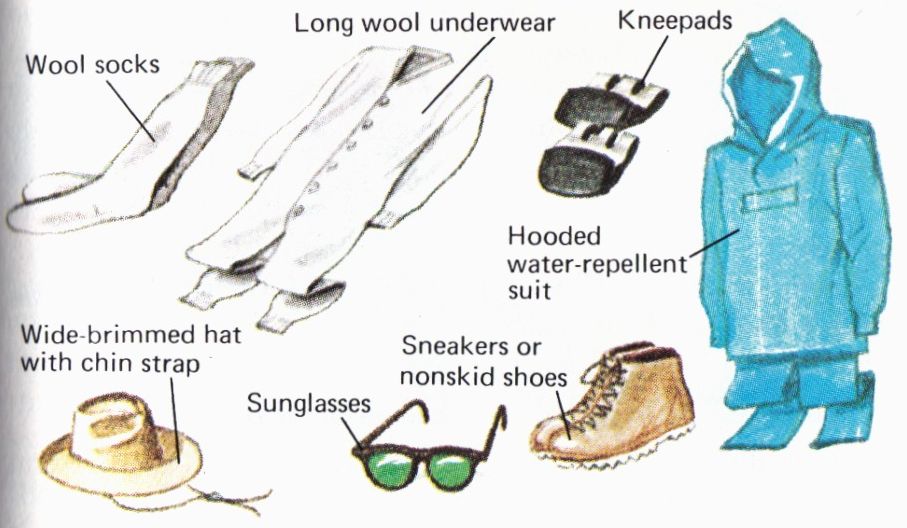
----------- Proper clothing and accessories will keep you warm and dry.
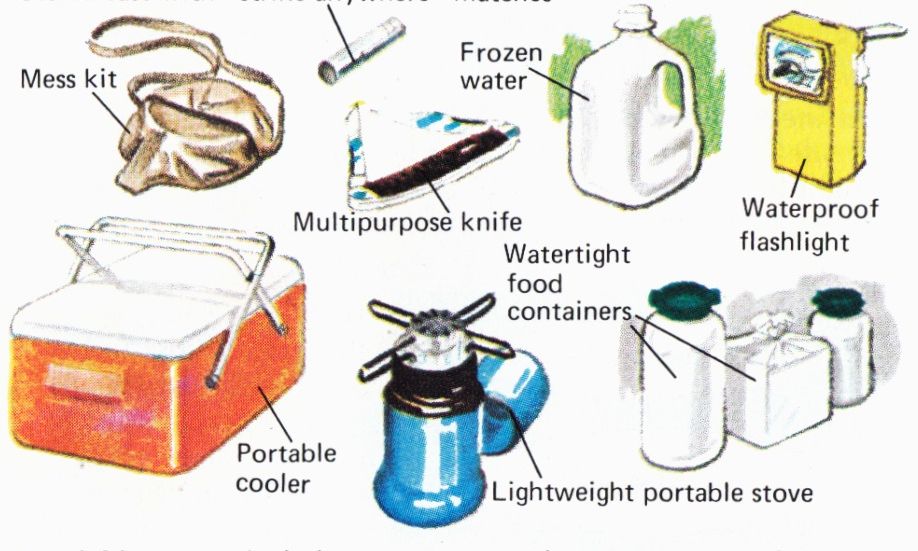
-----------------Special items include boating gear and sanitation supplies.
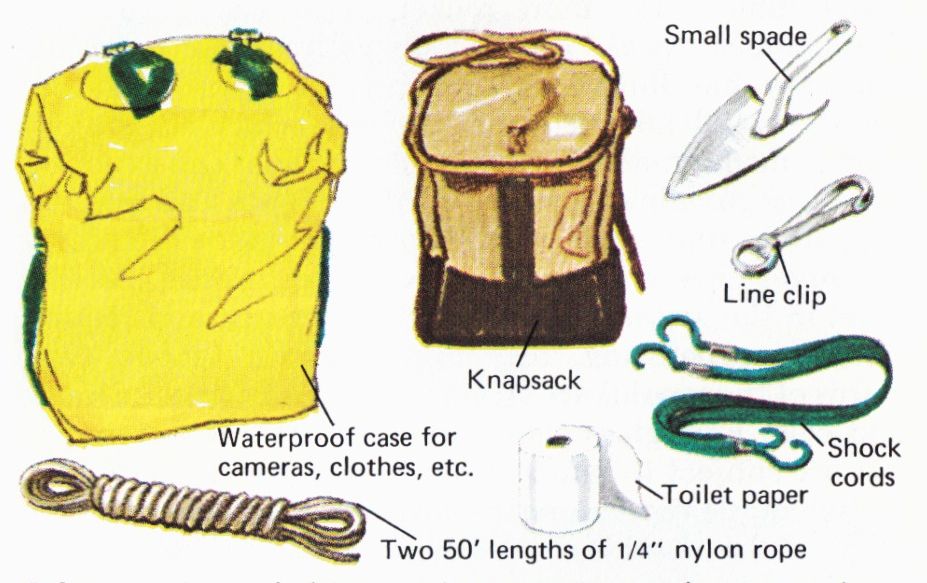
-------------Other gear is needed for comfort, camping, and emergencies.
Choosing equipment for a boat trip is a compromise between necessity and weight. An overweight boat is bard to handle and difficult to portage, but omitting a vital item, such as dry socks, a life jacket, kneepads, or suntan oil, may destroy much of the pleasure of a trip or even endanger your life. Usually, you can find a light weight version of the piece of equipment you need rather than leaving it out altogether.
Take along clothing that can be worn in layers; then as the temperature or your level of physical exertion changes, layers can be added or taken off. In cool weather many boaters routinely wear woolen union suits and socks, since wool will retain its warmth even when soaking wet. A long-sleeved shirt, long pants, and a vide-brimmed hat will help protect against sunburn--a major hazard of boating--and annoying insects as well. Sunglasses, particularly ones with polarizing lenses, greatly diminish glare from the water.
Canvas sneakers with rubber soles grip wet surfaces, do not trap water, dry out quickly, and will not slip off your feet as easily as moccasin deck shoes. Hooded rain suits are generally better than conventional raincoats or ponchos, which tend to become unwanted sails in strong winds. On all but the shortest trips be sure to take along a complete change of dry clothes.
Food is the fuel of a paddled boat. Backpacker's dried foods and other trail foods made especially for camping provide tasty, nutritious food without undue weight. Packing the food containers on the bottom of the hull out of the direct sun will help keep them cool. Water- treatment pills or chlorine bleach (three drops per quart and wait 30 minutes) will purify drinking water. Most small, light tents suitable for backpack camping will work well for boat camping.
"Keep it dry" is the first rule when packing a boat. Waterproof your supplies by tying them up tightly inside .food or garbage bags made of heavy-duty plastic, then put the plastic bags into duffel bags or knapsacks to prevent tearing. Most boat campers use a few large packs rather than many small ones and lash each of them down to prevent them from shifting in rough water or floating away should the boat capsize.
Whether you are loading a canoe or kayak, stow the heaviest cargo centrally, as close together and as deep in the hull as possible, in order to keep the craft's center of gravity low. In a kayak, which cannot be unpacked easily, load the gear you need most near the openings.
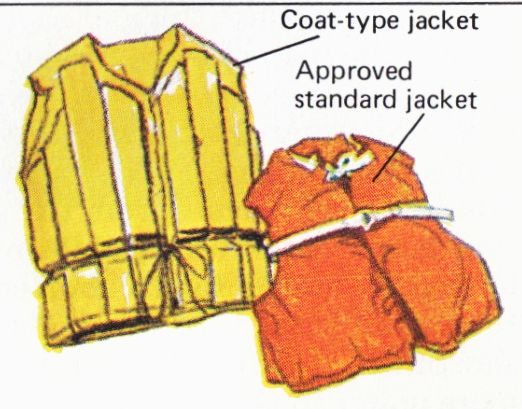
-----------Safety afloat
Life jackets are the most important of all boating equipment. The coat type (right) or the approved standard jacket (far right) should always he worn in the boat.
++++++++++++++++++
Canoes: From Showroom, To Car Top, to Water
There are many types of canoes, each with specific advantages and disadvantages. If you plan to use your canoe for overnight camping on lakes, you should choose a different style than if you intend to specialize in one-day river trips. Let experience be your guide. Rent before you buy, and discuss your needs with veteran canoeists to get a range of opinions.
All canoes resemble a peapod opened at the top-but the pod can be rounded, widened, sharpened, or flattened. Each design change influences handling. When selecting a canoe, look it over carefully and weigh the design factors in light of your boating preferences. As a rule of thumb, canoes with flat bottoms and flat keel lines, strong tumble home (side curvature), gradually tapering hulls, and moderate peaks are best suited for general cruising and camping. Round-bottom hulls, with less tumble home, more rocker (more arc in the keel line), and low peaks are best for white-water paddling. For easy handling and portaging, a general-purpose canoe should not weigh much more than 80 pounds. Many medium-sized canoes of various construction meet this guideline. A majority of canoeists find that the best all-around canoe is a 17- or 18-foot guide model.
Canvas-covered wooden canoes are lightweight and quiet in the water but are easily punctured and require frequent repainting. Aluminum canoes (about two- thirds of those sold) are strong and durable but are noisy and cold. Fiberglass canoes require little maintenance but are subject to puncturing. Newer plastic materials, including plastic laminates and polyethylene, combine many of the advantages of other materials without their drawbacks. They require little in the way of maintenance and are light, strong, and quiet; some of them even have a "memory"-after being dented or bent, they will return to their original shape either by themselves or with the help of a few minutes under a heat lamp.
When it comes to paddles, bigger is not better. The best all-around paddle is one with a moderate blade width of about 6 inches. The man in the bow should have a paddle that reaches from the ground to his chin; the sternman's paddle (or a paddle for a solo paddler) should be slightly longer, with a shorter, wider blade. Whether the paddle is made of wood, aluminum, or fiberglass, it should flex slightly when used: this springiness imparts more power to the stroke and provides more control.
Design Features

Bottom roundness refers to the degree of curvature of the underside of the hull. Standard profiles (left to right) are rounded, V-shaped, and flat. Flatness adds stability; round and V-shaped bottoms are faster and more maneuverable.
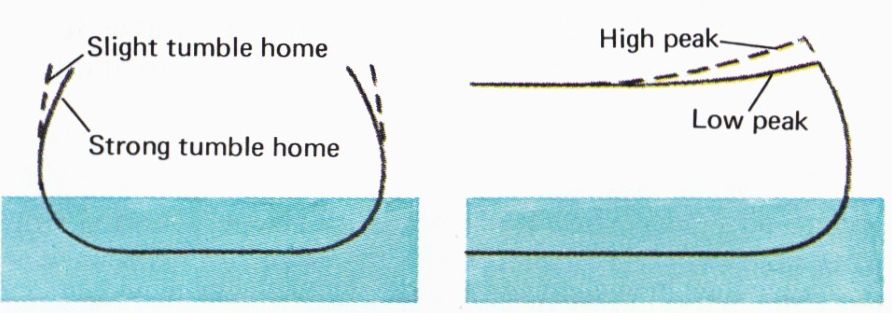
----------Tumble home is the inward curve of the sides of the hull. Tumble
home adds strength and makes paddling easier, but waves can slop over the gunwales
more readily.
----------Peaks are the top points of the canoe's bow and stern. High peaks make the boat more graceful but more susceptible to buffeting by strong winds.
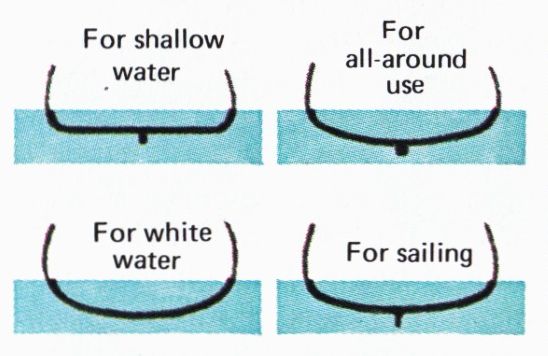
-------------Keels are ridges along hull bottoms. A prominent keel helps the
canoe steer straight but decreases maneuverability and increases the tendency
of the boat to he caught in crosscurrents.

----------Keel line refers to the profile of the keel viewed lengthwise from
the side. A boat with a flat keel line is easier to paddle in a straight line
in crosswinds and crosscurrents, but a rocker keel (upswept keel line) makes
for quicker turning.
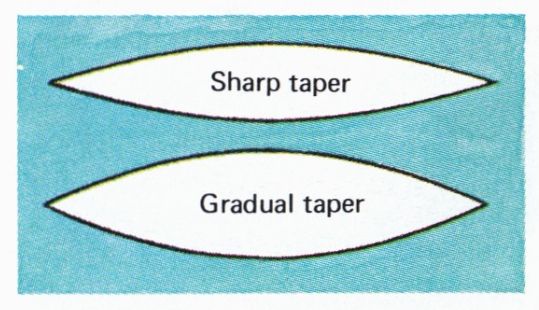
----------- Hull taper describes the shape of the hull as seen from above.
A gradually tapered hull can carry more weight. A sharply tapered hull is easier
to paddle and faster in the water.
Transporting a Canoe
Boating trips start on land, so the first task is to get the boat to the water. Standard car-top carriers work well for transporting a canoe. The craft should be inverted on the carriers and lashed down securely with bow and stern lines made tight to the car's front and rear bumpers. Some useful knots for lashing, as well as for general boating, are shown below. Plastic hooks attached permanently to the lines make the job faster and surely. Elastic shock cords can be run over the hull laterally to prevent the canoe from shifting on the carriers. You should check the lines several times during a long haul especially on a windy or rainy day.
Most river trips require at least two vehicles, one to take the canoeists to the start, the other to be left downstream for use at the end of the run. An alternative is a nonparticipating driver who is willing to drop off the canoeists at the starting point and then pick them up at a prearranged time at the end of their run downstream. Another solution is to use rented canoes: many outfitters provide a livery service for their customers, picking them up at the terminus and transporting them anti their gear back to the starting point.
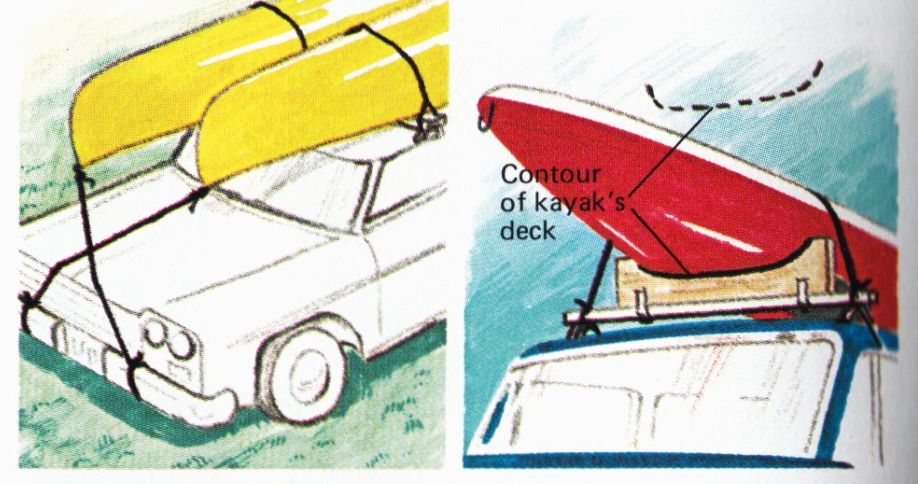
------ For long-distance hauls canoes and kayaks should be carried on the
roof of the car. Crossing the bowlines on two canoes adds stability. Kayak
mounts must be cut to fit the boat's deck.
The Useful Knot
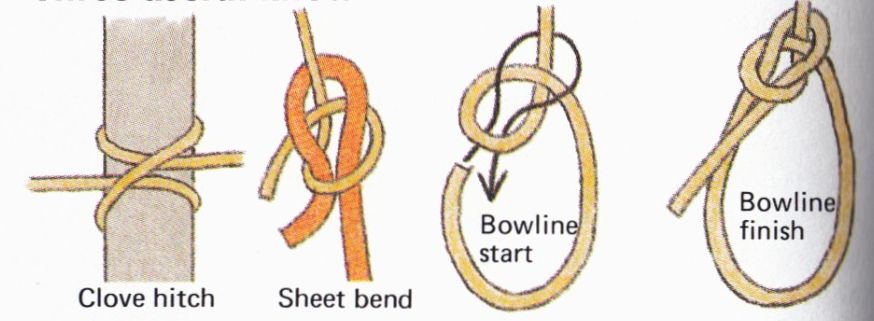
Clove hitch; Sheet bend; Clove hitch will secure rope to pier. Use sheet bend for joining ropes of unequal thicknesses. Bowline is valuable in rescues, since it does not slip under tension.
Principles of Propulsion and Steering
Practice the basic paddling strokes-back, draw, pry away, J, and cruise--until they become second nature. Once mastered, they will enable you to overcome almost any boating problem and let you paddle tirelessly for hours without wasting motion or energy. You will gradually learn that a little twist here and a little cross thrust re will easily accomplish what at first required frantic effort. Good paddlers make paddling seem effortless, but not expect to achieve this exalted state quickly; it takes time and training.
Some basic rules apply to all the strokes. First, make re that only the blade of the paddle is submerged; a paddle that is too deep or too shallow wastes energy.
Lean into each stroke slightly so that the muscles of your back and shoulders, as well as your arm muscles, get into the stroke. Pushing against the paddle grip with the heel of your hand provides most of the thrust. Your lower hand, which grips the paddle's throat, serves as an oarlock or fulcrum. Avoid using too much body English; it wastes energy and causes you to lose over the stroke. Begin your recovery when the e nears your hips, lifting the paddle and bringing it into position for the next stroke. Hesitate a moment between strokes. This brief rest will allow you to paddle much longer without tiring. The hesitation will also give r your paddling a beat or rhythm. The rhythm is especially important when two boaters are paddling together. Otherwise their paddling is haphazard and the boat is much more difficult to control.
When practicing the strokes, try to get a feel for how they affect the boat's movements so that you will know what strokes are necessary to turn the boat, slow it, or move it sideways. Then when you encounter a situation that requires skillful maneuvering, such as an obstruction, a crosscurrent, or rapids, you will be able to use the stroke that will keep the boat moving where you want it to. After a few trips you will find yourself switching strokes automatically as the situation demands.
The stern paddler handles most of the steering and captains the canoe by giving orders to the bow paddler, after sizing up the situation and deciding what strokes are necessary. The bow paddler helps by serving as a lookout for hazards. When one of the paddlers wants to paddle on the opposite side, the stern paddler calls out a signal, such as "shift," and counts down with each stroke to ensure that both switch sides on the same stroke. The exact signals used are not important as long as some system is agreed on. Changing sides without signaling ran result in a capsized canoe. Close friendships and even marriages have been strained during a canoe trip because of failure to arrange signals before setting out.
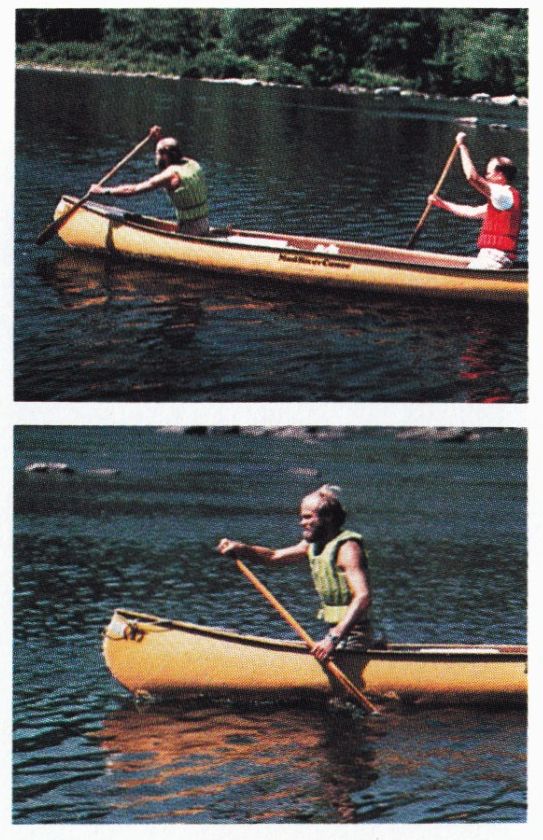
---------- Cruise stroke moves the canoe in a straight line. Bring the
paddle up and forward, dip it with the blade at a right angle to the hull,
and draw it straight back. Apply the power while the paddle is vertical-a relatively
brief period. The follow through is quite short, since little power is produced
after the paddle passes the hips. Lift the paddle and swing it forward in a
wide, low, outward arc until it is in position for the next stroke. When moving
the blade forward, feather it to cut through the air.
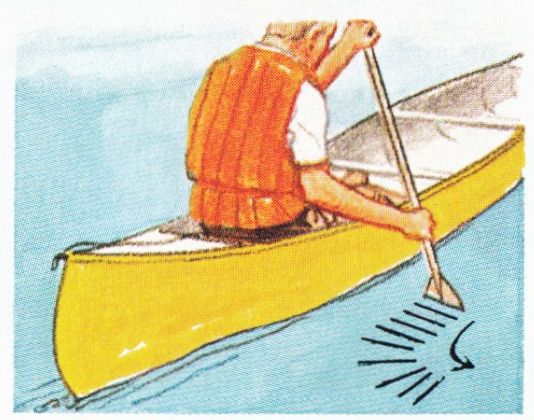
---------J-stroke enables , solo paddler to steer. Start a cruise stroke,
but just before the end turn the paddle and push it away from the boat, making
a hook, or J. By varying the hook, the boat can be made to turn toward or away
from the stroking side.
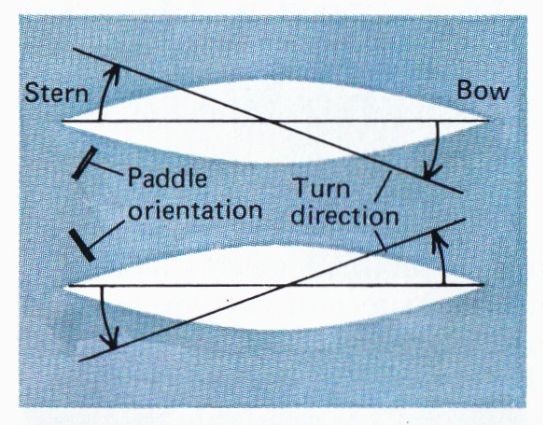
------------ Steering a canoe requires cooperation. To turn the boat,
the sternman uses his paddle as a rudder; the bowman paddles on the side opposite
the turn. To go straight, the bowman uses the cruise stroke; the sternman,
the J-stroke.
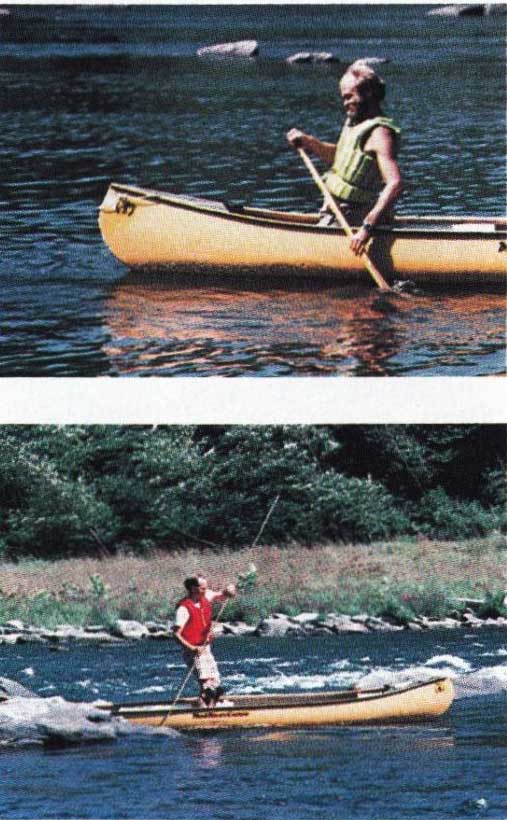
--------Back stroke slows, stops, or holds the canoe still in a current. Occasionally
you can even use it to back the canoe up. The stroke is the reverse of the
cruise stroke; start it on a line with your hips and push the blade steadily
forward.
--------Poling a canoe enables you to move upstream against a strong current. Keel) the pole close to the gunwale. Move the canoe forward by pushing the pole downward. Maintain the motion by pushing hand over hand up the pole.
Draw and pry strokes for quick turns
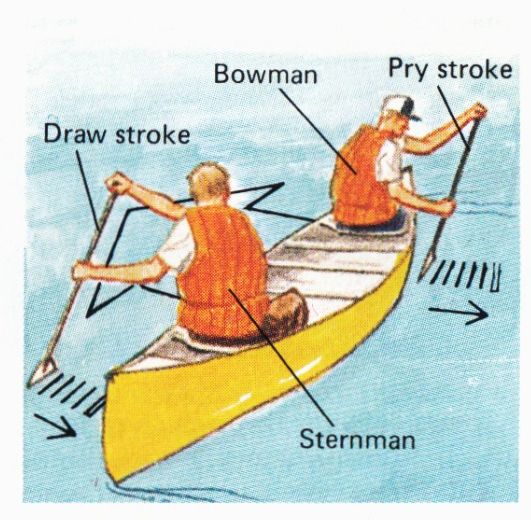
------------ Draw and pry strokes are opposites. In both
strokes move the paddle at right angles to the hull. The draw stroke pushes
water under the hull and moves the canoe toward the stroke. The pry stroke
pulls water from under the hull and moves the canoe away from the stroke. Both
strokes are useful to shift the canoe quickly to avoid an obstacle. Used in
combination by both paddlers, they can sideslip the canoe to avoid danger.
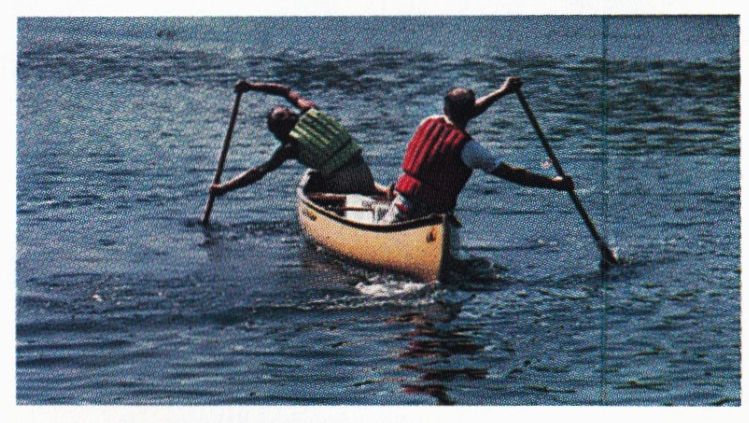
------------- Using draw strokes on opposite sides,
two paddlers can turn a canoe on a dime to change direction or avoid a hazard.
Similar effect can he accomplished with bow paddler using draw stroke and stern
paddler using pry stroke on same side.
++++++++++++
In Order to Master a River Learn to Read the Water
The sport of canoeing has its cerebral aspects as well as its physical ones. To run a river successfully, you must be able to read the water as if it were a book-observing its features, interpreting what they mean, and knowing how to handle them. Canoeists' maps are available that spell out a river's special problems and rate their difficulty, but the real interpretation must be done on the spot. And for this task there are no substitutes for experience, good judgment, and a cool head.
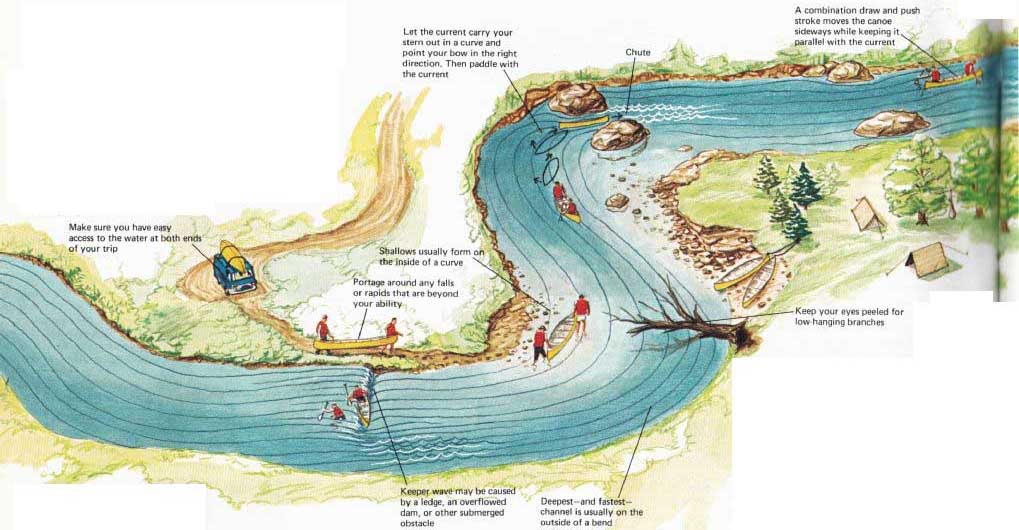
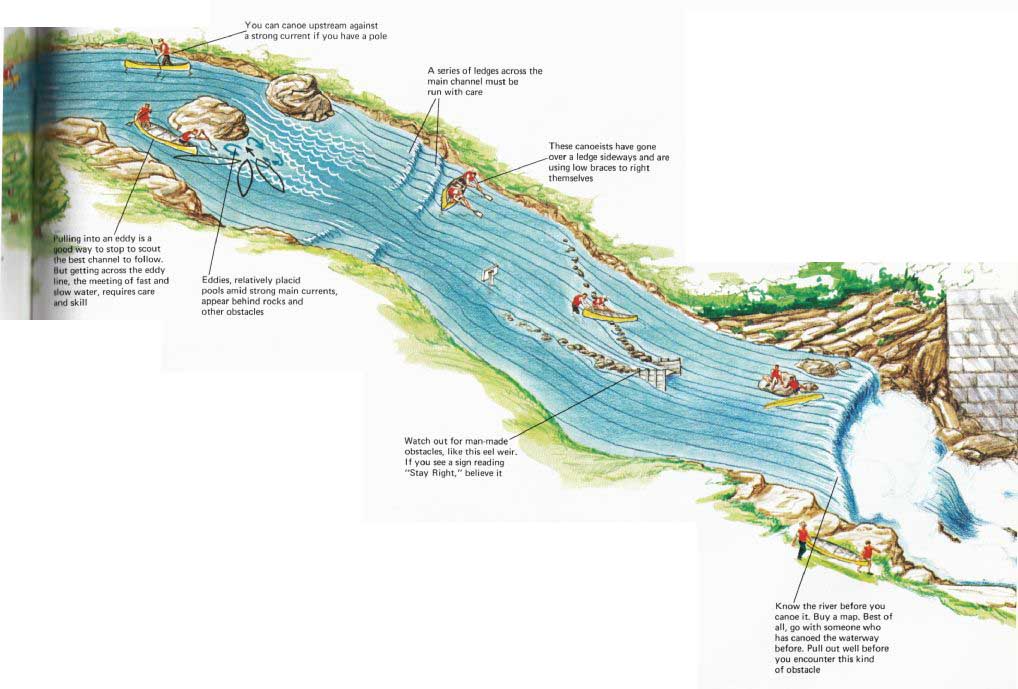
----Make sure you have easy access to the water at both ends of your trip.
----Let the current carry your stern out in a curve and point your bow in the right direction. Then paddle with the current
A combination draw and push stroke moves the canoe sideways while keeping it parallel with the current
---- Keep your eyes peeled for low-hanging branches.
---- Keeper wave may be caused by a ledge, an overflowed dam, or other submerged obstacle
---- Deepest-and fastest- channel is usually on the outside of a bend.
---- Pulling into an eddy is a good way to stop to scout the best channel to follow. But getting across the eddy line, the meeting of fast and slow water, requires care and skill.
Know the river before you canoe it. Buy a map. Best of all, go with someone who has canoed the waterway before. Pull out well before you encounter this kind of obstacle
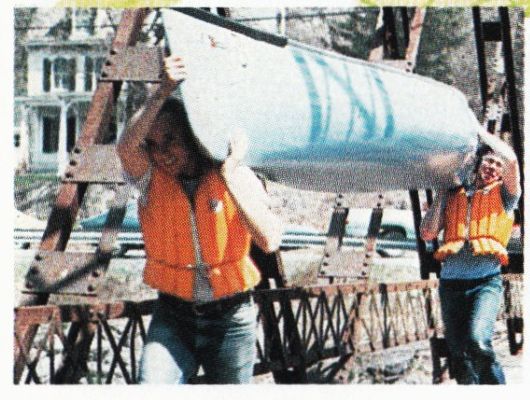
------- Portaging a canoe is often the only way to get
around an obstacle, such as a waterfall or rocky shallows. A two-man, right-side-up
carry is one of the easiest methods, since bulky gear can be carried in the
canoe.

--------- Keepers, pillows, and haystacks are signs of
hid den obstacles. Swift current over a deep hole produces a keeper wave that
can upset and trap a canoe; avoid it or meet it at a slight angle with speed
to carry through. A pillow--a smooth surface hump--means a rock below. Haystacks-
standing waves that form when swift water slows-usually provide a safe, exciting
ride.
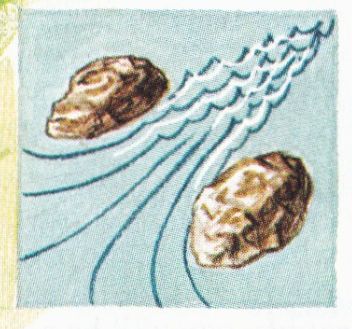
------------V's
are signposts in a river. V's that point upstream mark visible
or submerged obstacles. V's that point downstream usually show the way to clear,
safe water between rocks.
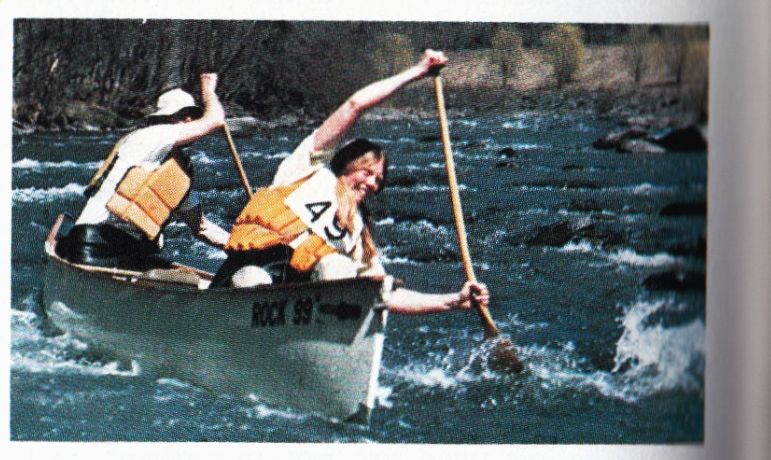
--------------Draw strokes push water under the side of the canoe, moving
it sideways. Contrary to what might expect, the strokes tilt the boat away
from the paddle. They help to counteract crosscurrent and provide control in
avoiding obstacles.
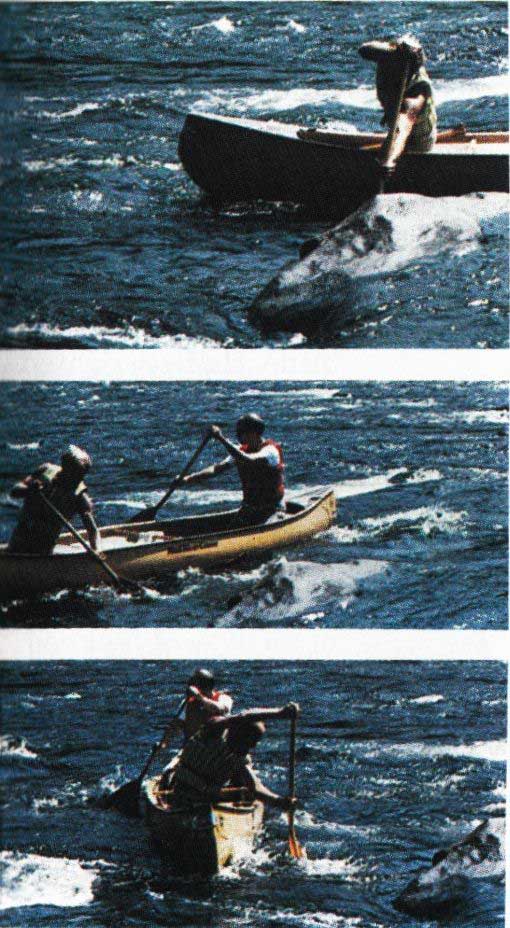
----------- Start eddy turn as the bow passes obstruction creating the
eddy. Bow paddler steers close to the obstruction while the sternman paddles
hard. When the bow crosses the eddy line into relatively still water, the stern
of the canoe will be forced around quickly-at this point the canoe may capsize
or be pulled out of the eddy and sent downstream backward. lithe bowman has
cut the corner sharply and if the canoe is moving fast enough, it will continue
into the eddy's calm water. Both paddlers then back-paddle to avoid shooting
out the eddy's other side.
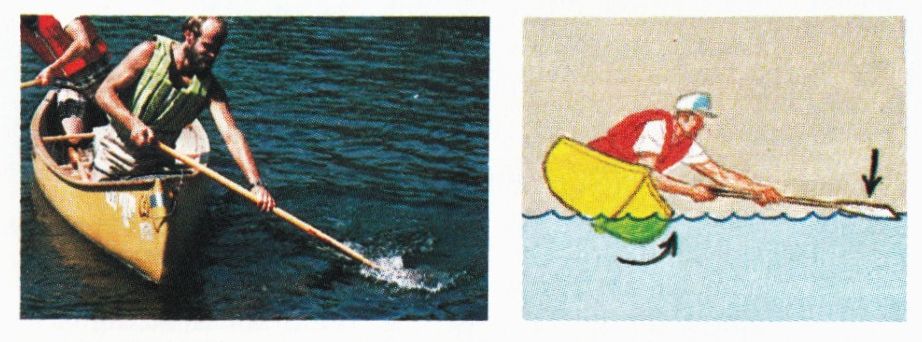
--------------- Low brace is a kayak stroke that also works in canoeing;
use it to right the boat rapidly, especially if it appears you are going to
tip over. Lean out over the gunwale on the side that is tilted down, and push
down quickly with the paddle, at the same time pivoting your lower body so
as to swing the boat upright.
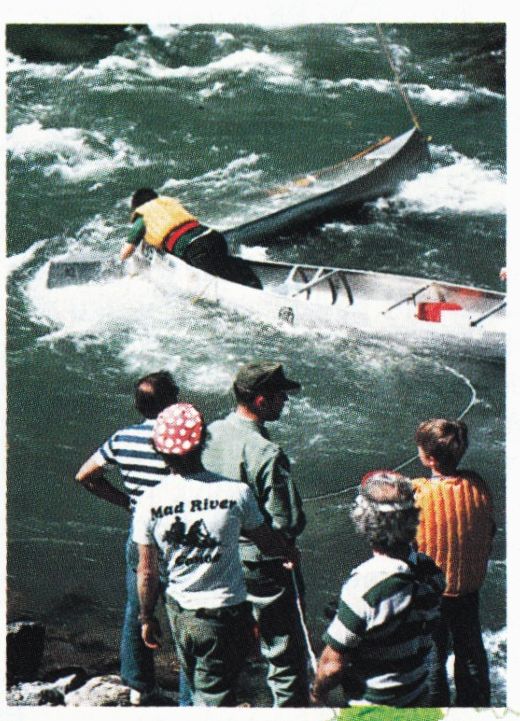
------------- Rescues often require rope, so always carry two 50-ft. lengths.
If the canoe capsizes, try to throw a line to shore. When running white water,
attach a line to each end of your canoe so the lines can be used to pull the
canoe away from an obstacle. If you take a spill, think of your own safety
first; the boat can be rescued later. Stay upstream of the boat and hang on
until help arrives. Always wear a life jacket and never boat alone.
++++++++++
Kayak or Raft: Different Paths to Freshwater Fun
Kayaks are light, fast, and maneuverable; a beginner cannot just jump into one and paddle it off down the river. But once you master a few basic techniques under the eye of an experienced teacher, new worlds of boating will open up-from mountainous surf to roaring rapids- that would be off limits with any other kind of craft. And yet not all kayaking is so fast paced. Some two-place kayaks are designed for cruising and camping in flat water; and if your taste is for serenity, a kayak will serve just as well as a canoe in a tranquil pond or placid lake.
Most modern kayaks are made from fiberglass or other reinforced plastic. Slalom kayaks have a wide, nearly flat hull for high stability and are considered by many boaters to be the best all-around type. White-water kayaks have V-shaped hulls and rakishly pointed bows and sterns for speed and for breaking through standing waves. Both types are available in one-cockpit or two- cockpit models. Some two-place kayaks have a mid-deck hatch for easy stowage of gear.
One almost wears a kayak, rather than rides in it, so it is important to choose a boat that fits. Generally, low-volume kayaks are unsuitable if you weigh more than about 150 pounds or intend to carry a lot of gear. A high-volume design is a poor choice if you weigh less than about 120 pounds. Before buying or renting any kayak, try it on to see if you can get in and out easily.
A kayak paddle has a blade at either end of its shaft. In use, one hand serves as a fulcrum while the other turns the paddle with a rotary motion. Paddles come in left- and right-hand models. The designation refers to the hand you prefer for rotation, not to whether you are a natural left-hander or right-hander. Quality in a paddle is vital; an inexpensive paddle is likely to break just when you need it most. Two- or three-piece paddles serve well as spares carried beneath the deck or taped to it. Most kayakers prefer paddles with curved blades, since these furnish more thrust. Paddle size depends on your height. If you are 6 feet tall, the paddle length generally recommended is 87 inches. For every 2 inches of height above or below 6 feet, add or subtract 1 inch of paddle.
If you are new to kayaking, practice a wet exit (getting out of a capsized kayak) before anything else-you will need the skill often. With someone standing by in waist- deep warm water to offer help if you need it, take a deep breath and capsize the kayak. Unfasten the spray skirt by pulling the front loop, place both hands on the gunwales beside your hips, and push the boat away from you as you bend your hips to free your legs. Many beginners make the mistake of trying to get to the surface before they leave the boat. The secret is to gel out of the boat first, then surface. Once you have the hang of it, practice the exit with your paddle. Do not let the paddle go, and do not lose contact with your kayak. Practice holding the paddle and the bow or stern grap-loop in one hand and swimming with the other. Three more safety tips that can save your life: (1) Never go kayaking without a safety helmet and life jacket. (2) Make sure your kayak has been fitted with secure flotation bags. (3) Always wear a wet suit in cold water.
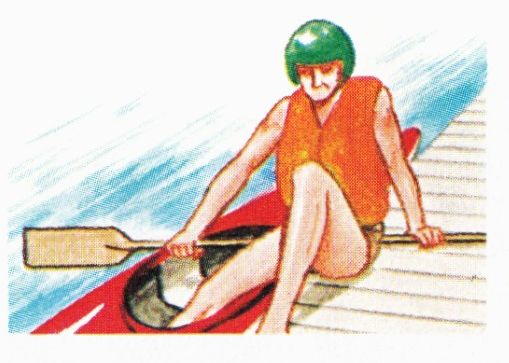
------------------- "Wearing a kayak" is boss kayakers describe
boating in these ultra maneuverable craft. An elasticized, waterproof spray
skirt snugly around the boat it waist and the rim of the cockpit to keep out
water even if the boat capsizes.
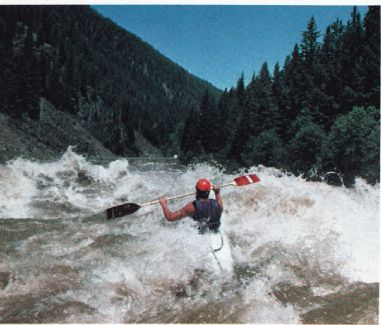
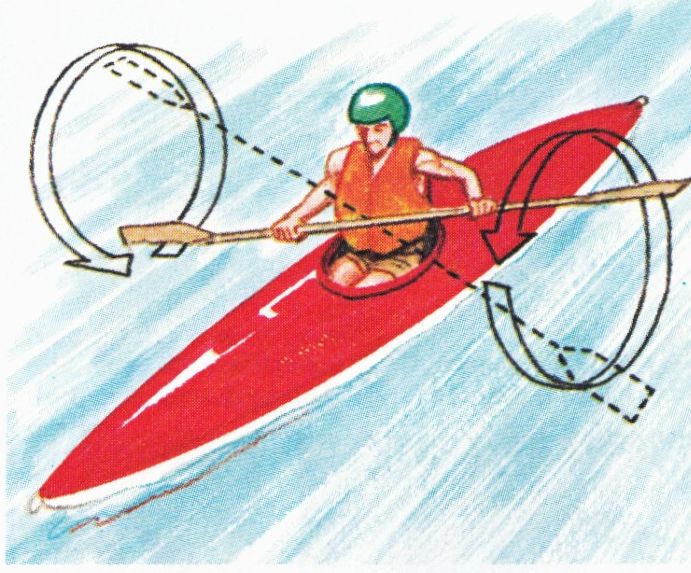
--------------- Double-bladed paddle helps give an experienced kayaker
control over his kayak in all kinds of water, even boiling rapids like those
at left. The paddle blades are set at right angles so that while one is pushing
the water broadside, the other is slicing through the air edgewise. The circular
motion of each blade (above) and the paddler's leaning and twisting enable
him to maneuver the kayak quickly in any direction, even sideways, making the
boat an extension of the boater.
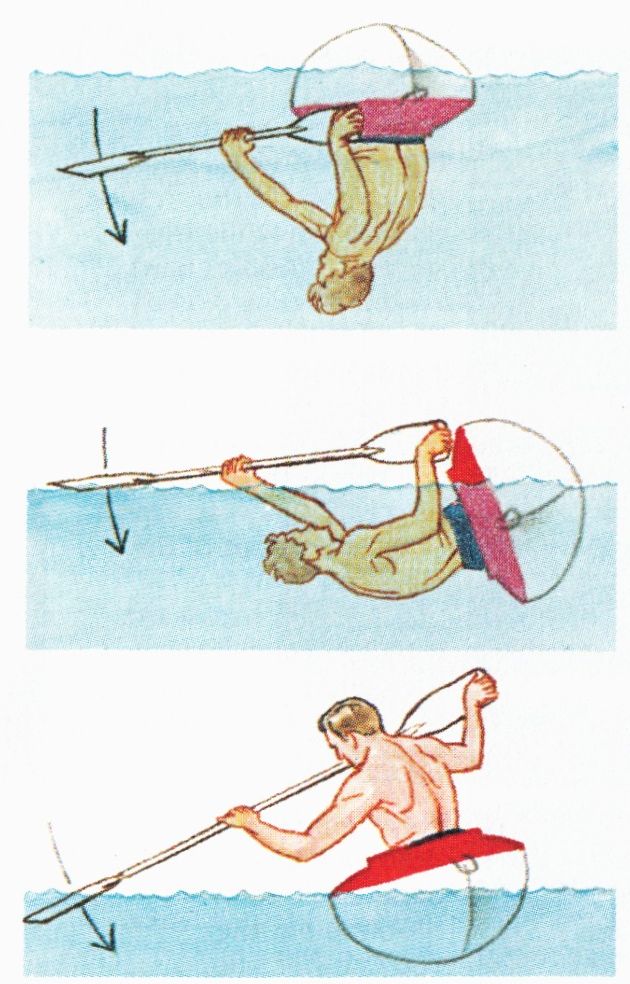
--------- Eskimo roll maneuver lets the kayaker right a capsized craft
without leaving it. Upside down and underwater, the boater grips the paddle
at the throat and at one blade (top), while pushing hard with the opposite
blade. Halfway righted (middle), the boater swings the paddle from the boat
in a wide arc, keeping the blade horizontal to prevent it from diving. When
the blade is out of the way of his head, the boater pushes it hard into the
water again. Finally, he rights the kayak with a hip snap, then swings his
head and shoulders up and out of the water (bottom).
Rafts--For the Tom Sawyer in You
Rafts are versatile, stable, and inexpensive. They are also fun to design, fun to build, and fun to use. You can make a serviceable raft out of almost anything that floats: logs, oil drums, plastic jugs, inner tubes. What ever materials you use, build the raft as close as possible to the water-so you will not have far to drag it-and )Serve all the rules of boating safety.
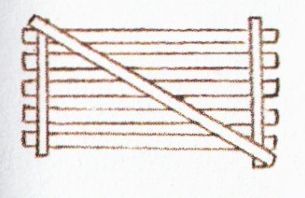
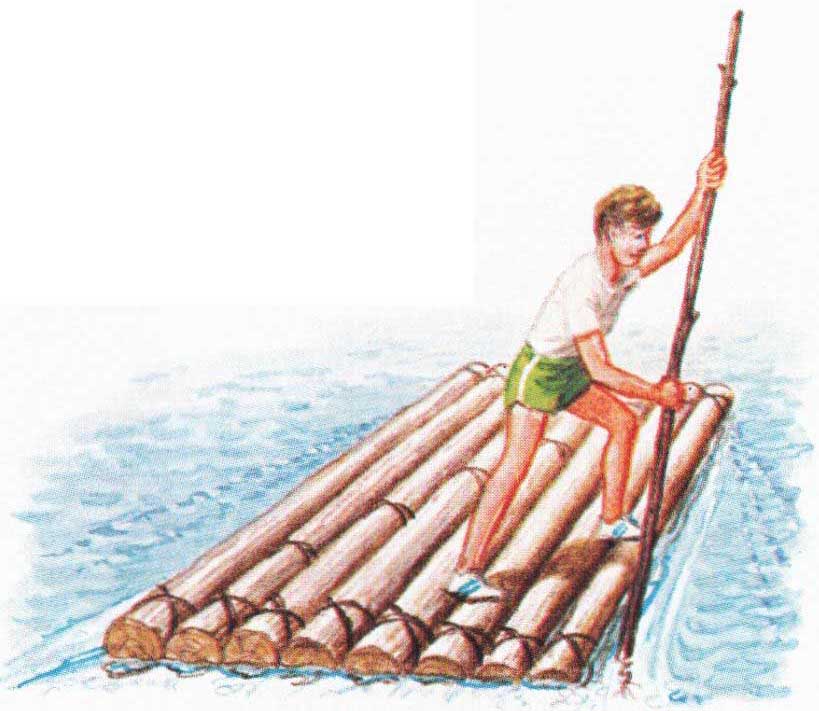
----- Log raft requires dry, buoyant wood. Lash smaller logs on top with strong
cord. Always lash one strong log diagonally to keep the raft from getting "whopper-jawed."

------Notch logs log-cabin style to give the craft additional rigidity. Use
an ax or saw to cut out matching slots on facing sides of the logs, and lash
with cord across and diagonally.
------Oil-drum raft is relatively light and very buoyant. Bore holes in planks, then pull strong cords through the holes and around the drums to bind both drums and planks together. Check the rigging after it gets wet, and tighten if necessary.
---------------
Henri Vaillancourt, Canoe Builder
Preserving a Vanishing Art
"I can't really explain what got me started on birchbark canoes. I was always interested in Indians anti the way they built boats. I was about five years old the first time I tried to make a birchbark canoe, hut I had an attention span of about a half-hour. I didn't succeed until I was 5 or so. I had an excellent book on hark canoes but a lot of what I did was trial and error. I work in the traditional Indian way, doing everything from scratch, or almost everything. I prepare the birchbark, the frame, and the root material that's used when you sew the joints. That's the whole joy of the thing, to see the canoe develop from the raw materials.
"I make about five or six canoes a year. Each one takes more or less a month to complete, depending on the length of the canoe; I've made canoes up to 24 feet long. I guess there's no common denominator among the people who buy the canoes except that they like traditional things. Some are canoers, some aren't c- Some of the canoes even go to museums.
"I don't really know anybody else who makes birch bark canoes these days, or at least anyone who makes so many of them. There are some Indians in Quebec making canoes, but even they are making them from canvas. But the Indians still make snowshoes out of birchwood with traditional techniques. In the winter I make snowshoes myself, the very fanciest of the traditional Indian kind.
"There are a lot of people interested in the techniques I use, and information about them is very scare. I'm doing research and making videotapes on Indian craftsmanship, not just snowshoes hut kayaks, clothes, sleds. The tapes will he available for people who want to find out about native manufacturing techniques. It's urgent to t these things recorded; if we don't do it now, in 20 years it will be too late."
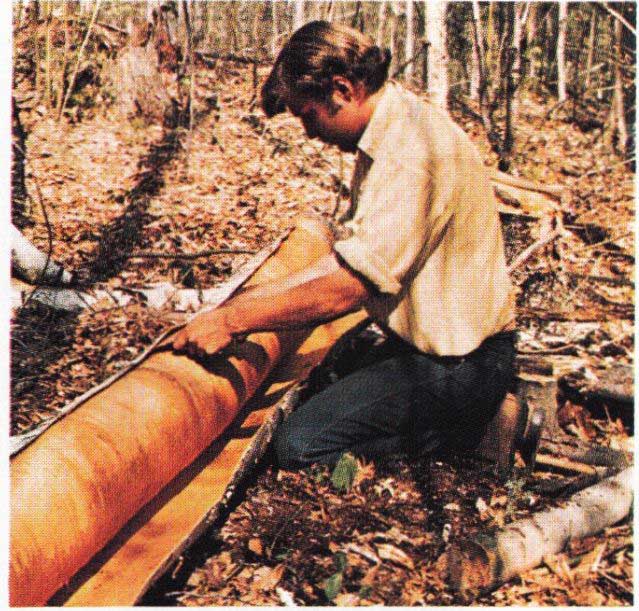
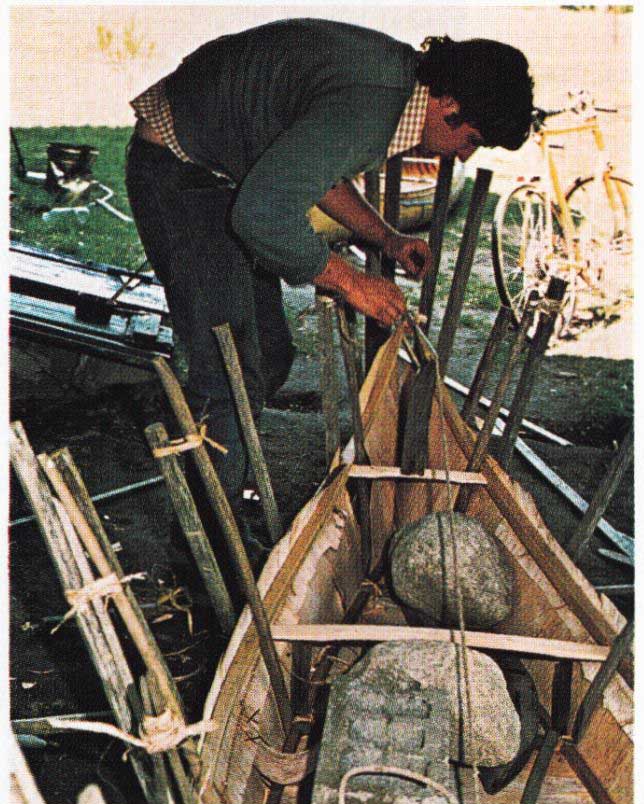
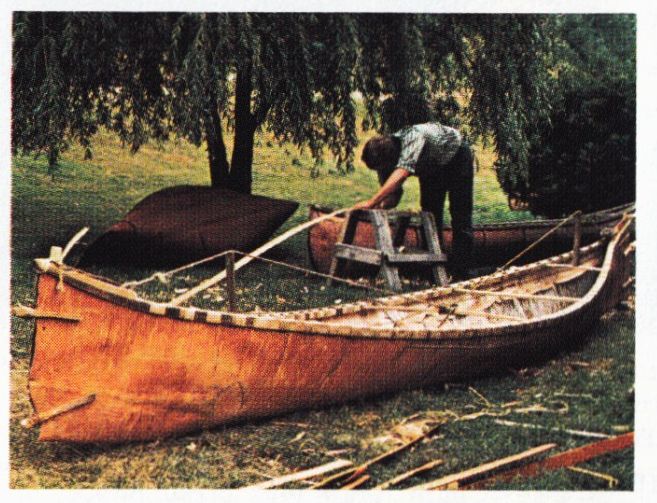
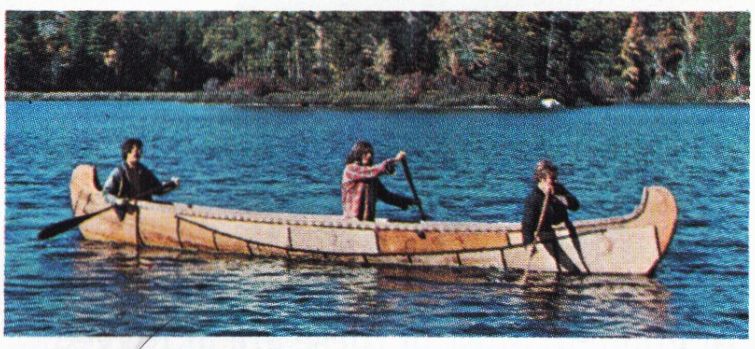
--------------Henri Vaillancourt, of Greenville, New Hampshire, builds canoes the traditional way. Counterclockwise from top: stripping bark, shaping the frame, shaving ribs, and testing the boat.
Sources and resources
Books and pamphlets:
P Reasley, Bob. Whitewater Kayaking. Birmingham, Ala.: Menasha Ridge, 1995.
Davidson, James W., and john Rugge. The Complete Wilderness Paddler. New York: Random House, 1982.
Evans, jay. The Kayakin Book. Brattleboro, Vt.: Alan C. Hood, 1993.
Glaros, Lou. Tandent Canoeing on Quiet water. Birmingham, Ala.: Menasha Ridge, 1995.
Kalman, Bobbie. A Canoe Trip. Federal Way, Wash.: Crabtree Publishing, 1995.
Mason, Bill. Path of the Paddle: An Illustrated Guide to the Art of Canoeing. Minocqua, Wis.: North Word Press, 1995.
M Nair, Robert E. Bask River Canoeing. Martinsville, Ind.: American Camping Association, 1968.
Mead, Robert D. The Canoer's Bible. Garden City, N.Y.: Doubleday, 1989.
Teller, Walter M., ed. On the River: A Variety of Canoe and Small Boat Voyages. Dobbs Ferry, N.Y.: Sheridan, 1988.
Ziegler, Ronald M. Wilderness Waterways: The Whole Water Reference for Paddlers. Kirkland, Wash.: Canoe America Association, 1992 Maps of coastal and inland waterways Defense Mapping Agency. Combat Support Center, Washington, D.C. 20315-0020.
National Ocean Service. Distribution Branch N/c C 33, Riverdale, Md. 20737.
Request free map catalog by number. No. 1: Atlantic and Gulf Coast. No. 2: Pacific Coast. No. 3: Alaska and Aleutians. No. 4: Great Lakes waterways
===